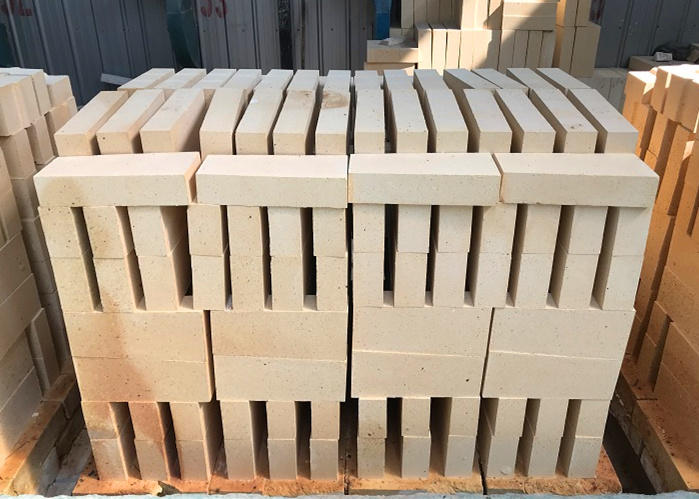Low creep high alumina bricks
Classification:
Product Introduction
Low creep high alumina brick is a refractory material with excellent performance, its main component is alumina (Al₂O₃), and the alumina content is high, generally 55% and above, and the specific content will vary according to different grades and production requirements. In addition, it also contains a small amount of other oxides such as silicon dioxide (SiO₂), iron oxide (Fe₂O₃) and other impurities, the content of impurities will affect the performance of bricks.
Performance characteristics:
High refractoriness: The refractory degree is usually between 1600-1800°C, which can withstand the test of high temperature environment, and is not easy to melt or soften at high temperature, ensuring the safety of use in high temperature industrial kilns.
Low creep rate: Creep rate is generally between 0.1% and 0.4%. Under the action of high temperature and constant stress for a long time, the deformation of the brick body is very small, which helps to maintain the structural stability of high-temperature equipment such as kilns, and reduces equipment failures and safety hazards caused by brick deformation.
Good thermal stability: It has good thermal shock resistance and is able to withstand rapid temperature changes within the kiln. In general, thermal shock resistance is expressed in the number of thermal shocks (1100°C water cooling) and can withstand 20-30 or more thermal shock cycles, which makes the brick less prone to cracking or damage during repeated heating and cooling processes.
Higher bulk density: The bulk density is generally between 2.4-2.8g/cm³. The high bulk density makes the brick have higher strength and better wear resistance, and can withstand the material erosion and friction in the high temperature environment, which prolongs the service life of the brick.
Good chemical stability: it can resist the erosion of many chemical substances, and has a certain corrosion resistance to alkali metals, sulfur, chlorine, etc. in a high-temperature environment, and is not easy to react with chemicals in the kiln, ensuring the performance stability of bricks.
Production process:
Raw material selection: select high-quality high-alumina bauxite clinker as the main raw material, and add some auxiliary raw materials such as andalusite, activated alumina, etc., to improve the performance of bricks.
Formula adjustment: strictly control the ratio of raw materials to ensure that the ratio of alumina to other oxides is appropriate, so that the matrix composition of the brick is close to or completely mullite, and the high-temperature performance of the brick is improved.
Forming and sintering: After process steps such as mixing and molding, sintering is carried out at high temperatures. During the sintering process, temperature, time and other parameters should be controlled to ensure the quality and performance of the bricks.
Specifications:
In terms of shape, there are not only common square bricks, but also special-shaped bricks can be customized according to specific needs, such as arc, wedge, etc., to meet the masonry requirements of different kilns.
In terms of size, the common standard sizes are 230mm× 114mm×65mm, etc., but special sizes can also be processed according to customer requirements.
Applications:
Blast furnace hot blast furnace: It is one of the main application areas of low creep high alumina bricks. In the hot blast furnace, the bricks need to withstand high temperature, high pressure and gas erosion, etc., and the excellent performance of low creep and high aluminum bricks can meet the requirements of the hot blast furnace and ensure the normal operation and long service life of the hot blast furnace.
Glass kiln: The operating temperature of the glass kiln is high, and the requirements for refractory materials are also high. Low creep high alumina bricks can withstand the high temperature environment in the glass kiln, and have good resistance to glass liquid erosion, which can be used in key parts of the glass kiln, such as the inner lining of the kiln, the flame vent, etc.
Other high-temperature industrial kilns: such as cement rotary kilns, electric furnaces, aluminum-making furnaces and other high-temperature industrial kilns, low-creep high-alumina bricks are also used to withstand high temperatures, resist chemical attack and thermal stress, etc.
| Projects | Physical and chemical indicators | |||||||
| DRL-155 | DRL-150 | DRL-145 | DRL-140 | DRL-135 | DRL-130 | DRL-127 | ||
| (Al₂O₃)/% | ≥ | 75 | 75 | 65 | 65 | 65 | 60 | 50 |
| Apparent porosity/% | ≤ | 20 | 21 | 21 | 22 | 22 | 22 | 23 |
| Bulk density/(g/cm3) | 2.60~2.85 | 2.60~2.85 | 2.50~2.70 | 2.40~2.60 | 2.35~2.55 | 2.30~2.50 | 2.30~2.50 | |
Compressive strength at room temperature MPa | ≥ | 60 | 60 | 60 | 55 | 55 | 55 | 50 |
| 0.2Mpa creep rate/% 50h | ≤ | 1500℃ 0.8 | 1500℃ 0.8 | 1450℃ 0.8 | 1400℃ 0.8 | 1350℃ 0.8 | 1300℃ 0.8 | 1270℃ 0.8 |
| Heating permanent line changes/% | Xmin Xmax | 1500℃X2h -0.2~0.2 | 1450℃×2h -0.2~0.2 | 1450℃×2h -0.3~0.2 | ||||
Key words:
Low creep high alumina bricks
High-alumina bricks
Related Products
Product inquiry


